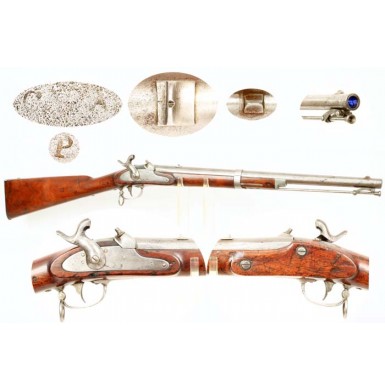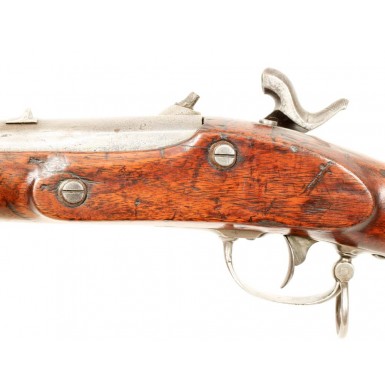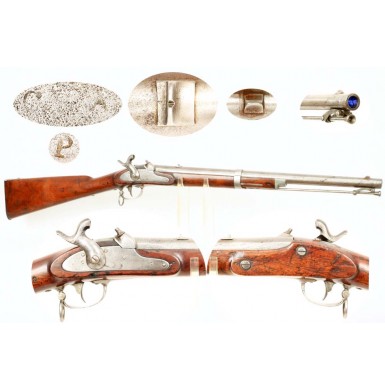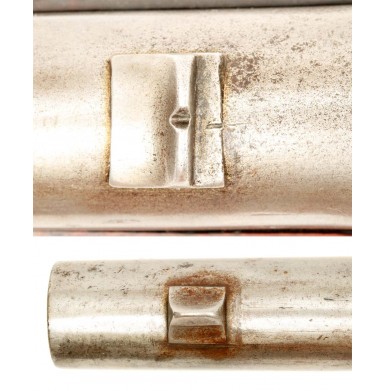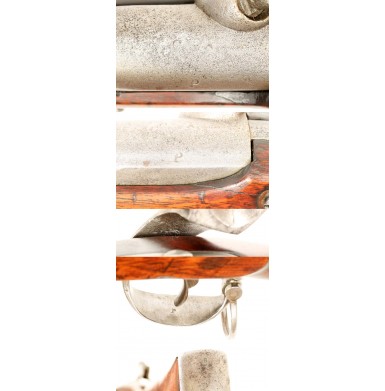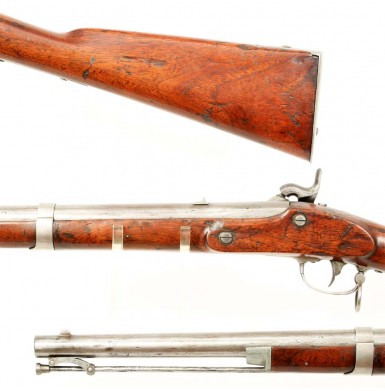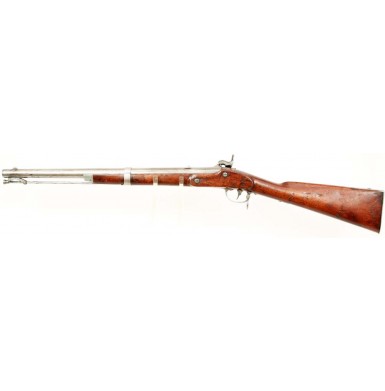Bilharz, Hall & Company Rifled Carbine - Extremely Rare
- Product Code: FLA-3144-SOLD
- Availability: Out Of Stock
-
$1.00
The American Civil War found the newly formed Confederate States of America sadly lacking in the industrial might necessary to prosecute a war. With the bulk of the manufacturing capacity of the pre-war United States located in the north, the south was essentially required create an arms production industry from scratch. Numerous small firms were established throughout the south in an attempt to manufacture various types of small arms; some meeting with limited success and some failing miserably. One firm that was both successful initially, but was forced out of business due to the exigencies of war was Bilharz, Hall & Company of Pittsylvania Court House (known today as Chatham), Virginia. The arms making business was established by an immigrant from the German State of Baden named Claudius Bilharz, who became a naturalized American citizen in 1859. The firm also included the partners George W. Hall and Colonel L.D. Bennett. Bilharz appeared to be the primary businessman with manufacturing experience in the partnership, and had been listed in various directories of the period as a harness maker, distiller and mechanic. The company grew to be at least fairly successful initially, as by mid-1863 they employed some 36 workmen in their facility. The first deliveries made to the Confederate Ordnance Department by Bilharz, Hall & Company were in the late summer or early fall of 1862, and on September 16 of that year they were paid $4,500 for “100 Breech-loading carbines”. Subsequent research has determined that these were the unique “Rising Breech” carbines that continue to fascinate and confound Confederate arms researchers, as they are truly strange weapons. Their manufacturing origin was initially difficult to ascertain due to the fact that they are not marked with any maker’s name. Upon completion of this contract, Bilharz, Hall & Company apparently received a new contract to manufacture a percussion muzzleloading carbine based upon the US M-1855 Rifled Carbine. For many years these unmarked, Confederate copies of the US M-1855 Rifled Carbine had been attributed to the Georgia firm of D.C. Hodgkins & Sons, and in fact these carbines are still found under that heading in Flayderman’s Guide to Antique American Firearms, with the caveat that more recent scholarship has determined that the real maker of these carbines was in fact Bilharz, Hall & Company of Virginia. It has been postulated that the majority of the US M-1855 Rifle Carbines that were issued for service with six companies each of the 1st and 2nd US Cavalry during 1855-56 and the guns were subsequently turned in circa 1858 when newer weapons like the Sharps carbines were issued instead. These returned carbines were stored in the San Antonio Arsenal. As a result, these guns fell into Confederate hands when the arsenal was taken over by Texas state troops in February of 1861. Why the this particular pattern of musketoon was chosen as the basis for the Bilharz, Hall & Company guns is not known, but the design of the Confederate carbine generally conformed to the overall appearance of its pre-war US counterpart, with some minor changes. The US M-1855 was a single shot muzzle loading percussion carbine with a 22” long barrel that was secured by a single barrel band and screw through the breech plug tang. The musketoon had a .54 caliber bore that was rifled with 3 grooves. The gun had a swivel style ramrod secured by a pair of arms to a stud under the muzzle, and a small, three-leaf rear sight, similar to that used on the British Pattern 1856 cavalry carbine. The gun was iron mounted with the exception of a brass nose cap, and instead of the conventional carbine sling bar and ring on the stock opposite the lock, a sling ring was secured to the rear of the triggerguard bow. The Bilharz manufactured variant retained the iron-mounted design with a swivel ramrod, but dispensed with the adjustable rear sight, opting for a simple fixed one. The Bilharz gun was also bored to .58 caliber, making it compatible with the .577 and .58 ammunition used by most of the Confederate infantry. The Bilharz carbines initially utilized a brass nose cap like their US counterparts, but after about 350 were manufactured the brass piece was replaced with a pewter nose cap that remained in use through the end of the manufacturing period. The initial sample of the Bilharz, Hall & Company muzzleloading carbine was submitted for examination and review at the Richmond Armory in early March of 1863. Major William Downer, in command of the armory at Richmond at that time, wrote a detailed report about the Bilharz sample musketoon on the 4th of March 1863. In general he found the overall workmanship of the gun to be “rough”. He specifically noted a number of what would appear to be minor flaws, such as the angle of the buttplate, the sharpness of wood corners, etc., as well as some major flaws such as a tumbler made of iron and the use of common wood screws to secure the buttplate and some furniture to the gun’s stock. He found fault in the design of the captive ramrod (and suggested some improvements) and complained that the stock had no “tip” (forend cap). His biggest complaints, however, were that “The barrel is not finished smoothly, either inside or out. The inside should be improved in boring” and in reference to the iron tumbler noted that it “is not casehardened, rendering the lock very rough, and liable to get out of order very soon.” Interestingly after castigating the gun on many points, he concluded by saying: “The general finish of the arm is rough, but with the exception of the tumbler, I see nothing to prevent the usefulness of it in the field. If the improvements and alteration mentioned are made, I should think that forty-five dollars would be a reasonable price for the arm.” This comment is interesting on a number of levels. On the surface it indicates that Downer considered a rough gun better than no gun. More importantly it underscores the inflation that was already hitting the Confederacy in the spring of 1863. Only a few months earlier, Bilharz had delivered 100 breechloading carbines at $45 each, and six months later he was able to ask the same price for a much simpler to produce muzzleloading carbine. The inflation was no doubt due to the lack of the necessary raw materials, especially metals like iron and steel, much of which had to be imported from Great Britain. The inability to find an adequate supply of these materials appears to be the primary reason that the carbines were delivered in limited quantities. Although no copy of a contract or official order for the guns is known, it is generally believed that the Confederate War Department agreed to purchase 1,000 of these carbines from Bilharz, and based upon the “serial numbers’ of extant examples it is believed that between 700 and 800 were finally completed. Despite Major Downer’s commentary about the general “roughness’ of the guns, he also agreed to purchase gunstocks from the company for the production of the Richmond muzzleloading carbine and the Richmond Sharps carbine. A May of 1863 letter indicates that Bilharz was billing the War Department for “650 short stocks” and “1095 long stocks” at $1.00 each. I would think that the “short stocks’ were for the Sharps pattern carbines and the “long stocks’ for the conventional musketoons. Bilharz was apparently extremely active between March and May of 1863, as in addition to the 1,745 stocks, he also delivered 191 of the muzzleloading carbines on May 22, 1863. However, production soon slowed due to a lack of raw materials. By September Bilharz was trying to buy various types of raw iron and steel bar stock from the Ordnance Department as well as percussion cones (nipples), and emery cloth. Additional requests were made the following month as well, suggesting it was getting harder and harder to obtain the necessary materials. Although some of the requests were finally fulfilled, the company received about 400 of the requested percussion cones over the ensuing months, many of the requests for materials were not granted, or were supplied in much smaller quantities than needed. The shortage of raw materials must have lead the Ordnance Department to believe that Bilharz would not complete his contract, which was apparently due to expire in early December of 1863. Like vultures circling a dying animal, the Ordnance Department started looking to “buy” (more likely appropriate) the Bilharz machinery and hire away his workmen when the venture collapsed. To that end, the Ordnance Department even hired a machinist to appraise Bilharz’s equipment in November of 1863! Somehow, Bilharz either received a contract extension or some leniency from Richmond, and in March of 1864 the firm was still requisitioning raw materials from the Ordnance Department and was apparently still delivering carbines to Richmond. The Ordnance Department did, however, manage to hire away several of Bilharz’s best workmen and put them to work at the Richmond Armory, which no doubt had a negative impact on the speed and quality of the later guns that he would deliver. Based upon the documented delivery of 191 carbines in May of 1863, the receipt of some 400 percussion cones over the next several months, and the fact that a highest known example has a barrel numbered 704, the general belief is that about 750 of the guns were delivered, give or take. The guns are not serial numbered per se, but do have a number on the rear of the barrels, and often the same number is found under the breech plug as well. The guns themselves show a variety of cryptic marks, usually involving an alphanumeric assembly number to match parts, and various “cryptic letter” inspection marks like those found on some Confederate produced revolvers and a “P” proof like the one found on Keen, Walker & Company “Tilting Breech” carbines. As the barrels were purchased at a rate of “$10 for rough barrels” according to Downer’s original assessment of the carbine, it is possible that the P proof found on the barrels and so similar to that found on the Keen, Walker & Company carbine may indicate that both barrels came from the same source (Keen, Walker & Co”). Since Keen, Walker and Company was located only about 20 miles south in Danville, VA, they may have been a logical supplier for “rough barrels”. It is also possible that all of the barrels from both companies were proved (inspected) at the arsenal in Danville. Other than the “cryptic letter” inspection marks and the mating marks, the only other mark typically encountered on the guns are the letters CSA, individually stamped at the breech of the barrel. There are no maker marks on the guns, which is one of the reasons that it took scholars so long to determine the true origin of these Confederate carbines. Although production is assumed to be 750 +/- based upon the known “serial numbers”, as those numbers only appear on the barrel it may not be an indication of anything more than how many barrels were made. If the alphanumeric mating system is more of a batch numbering system, assuming that approximately 100 guns were made with each letter combination, than known examples would suggest that 400 to 500 is a more accurate number, as the highest mating letter I am aware of is “D”. Assuming the first 100 had no letter and than A, B, C and D each had 100 guns, the maximum delivery would be about 500 guns. This would coincide more closely with the known examples noted in the monumental work Confederate Carbines & Musketoons by John Murphy and Howard Madaus, as they only note 9 known examples: 2 with barrel “serial numbers’ under 350 with brass nose caps (“1st Type”) and the rest with “serial numbers’ above 350 with pewter nose caps (“2nd Type”). Whether it was a lack of raw materials, the loss of his most skilled workmen to Richmond or both, it appears that the Bilharz firm stopped making and delivering arms sometime in the last half of 1864.
Offered here is a FINE example of a “2nd Type” Bilharz, Hall & Company Rifled Muzzleloading Carbine. The gun is “serial number” 428 and is listed in the Murphy & Madaus book among the extant examples known to the authors in 2002. The gun was also published more than a decade earlier in the Time-Life Series Echoes of Glory and appears with two other Confederate made muzzleloading carbines and a sawed-off shotgun in a two page spread (pages 44-45) in the volume Arms & Equipment of the Confederacy. The gun was also featured in another two page photo layout (pages 78-79) of William C. Davis' 1989 Fighting Men of the Civil War. At the time of both publications (1989 & 1991) the gun was in the famous Confederate arms collection of Russ A. Pritchard Jr. It has since been through several hands and is offered here now as a wonderful example of a very scarce, Confederate made carbine. As noted the rear of the barrel is numbered 428, and the bottom of the breech plug bears the matching number. The alphanumeric assembly number D 10 is found throughout the gun. The mark is under the barrel, inside the lock plate, inside the hammer neck, on the trigger and in the wood behind the triggerguard. In most cases the gun must be disassembled to find the mark. The mark in the wood is stamped 10 / D in two lines. The upper rear of the buttplate is stamped with a cryptic B and the inside of the triggerguard bow is stamped with a P. The internal lock parts bear the assembly code 60 / C or simply 60. The first mark is found on the rear interior of the lock plate and just the number is found on the tumbler and sear. The top of the barrel breech is stamped C S A, although the “S’ is weak due to some light flash pitting in the area. The upper left side of the breech bears a P proof, of the same type found on Keen, Walker & Company carbine barrels. Other than the assembly and inspection marks, there are no other markings, and the exterior of the lock in particular is shows no marks. The gun shows the “rough” construction that Downer complained of throughout. The lock in particular shows numerous flaws on its surface and the metal components show even rougher work when they are removed from the stock and the hidden parts of the metal are examined. The iron stock washers through which the lock mounting screws pass are particularly rough, and when looked at closely are not even round, but more like roughly made ovals trying to be round. The screws that secure the buttplate and triggerguard are not much more than the “common wood screws” that Downer decried, and they are clearly handmade and with much finer threads that are typically found on screws that secure 19th century firearms furniture to the stock. The gun appears to be 100% complete, correct and original in every way, down to the last screw. The captive swivel ramrod is original and fully functional and the original pewter nose cap is in place at the end of the stock as well and is secured by its original wood screw. Both the crude fixed rear sight and the pinched, Richmond-style front sight are correct and original to the gun as well. Even the round swivel copied from the US M-1855 carbine is original and in place on the rear bow of the triggerguard. The gun has an attractive pewter patina and was likely very lightly cleaned a very long time ago. However there is no indication that the gun has been cleaned or touched in any way affecting its appearance since it was photographed for the Echoes of Glory series, sometime prior to 1991. The metal is mostly smooth throughout with some light flash pitting present at the breech, and a few other areas of light pitting present as well, with the buttplate showing the most other than the breech. There is also some lightly scattered pinpricking and minor surface oxidation scattered along the barrel and some of the iron furniture. There are also some scattered areas of freckled light age discoloration that accompany the light oxidation on the metal. The bore of the carbine remains in about FINE condition as well and retains deep rifling for its entire length, even if the quality of the rifling is somewhat crude and rough. The bore shows some light to moderate scattered pitting along its length but shows no significant erosion. The lock of the carbine is mechanically excellent and not nearly as “rough” in operation as Downer’s report would suggest. The lock snaps crisply into both the half cock and full cock positions and responds to the trigger, as it should. As noted, the many small parts that would typically be lost or broken on a cavalry carbine are present and original, including the swiveling ramrod, the sights and the sling ring. The stock of the gun is in equally FINE condition as well. It is solid and complete with no breaks or repairs noted. There is a tiny hairline crack that runs from the rear lock mounting screw to the barrel channel. This is a crack that is present in the large majority of 19th century military arms and that results from over tightening of the lock screw. The stock retains good clean edges that remain mostly sharp and shows no signs of having been sanded. Any rounding to the edges appears to be from actual use. The stock does show a number of bumps, dings, rubs and minor mars, but these are all typical of a cavalry carried long arm that is more than 150 years old. In fact the series of dings and mars on the obverse stock and the stock wrist are what allow us to positively confirm that this is the gun pictured in the Confederate volume of Echoes of Glory, as these dings are like a finger print that clearly identifies the gun.
Overall this is a really wonderful example of a very scarce and completely correct Confederate made percussion muzzleloading carbine with a wonderful ownership provenance and great documentation, having been pictured in Echoes of Glory, Fighting Men of the Civil War, and listed by number in Confederate Carbine & Musketoons. Rarely do these Confederate made guns appear on the market and almost never with the fine chain of provenance and documentation that this gun carries. In fact, a hardcover copy of Echoes of Glory Arms & Equipment of the Confederacy will accompany this gun. Considering that in 2002 Murphy & Madaus knew of 16 extant Bilharz, Hall & Company “Rising Breech” carbines, a gun that sells in the $45,000 to $60,000 range and only knew of 9 of these muzzleloading Bilharz carbines makes this a truly rare gun, but at about half the price of a “Rising Breech”! While maybe not as “sexy” as a Confederate made breechloader, this rare carbine will be a fantastic addition to your collection of Confederate arms and is one you never have to explain to anyone or worry about its authenticity.
Provenance: Robert Berryman (directly from the family in Atlanta c1965, name unknown), R.A. Pritchard Jr., Don Tharpe, private collections.
SOLDTags: Bilharz, Hall, Company, Rifled, Carbine, Extremely, Rare

